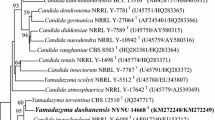Abstract
Thirty-two strains, many of them isolated from wood-associated habitats, and designated as Kuraishia (Pichia) capsulata and Candida molischiana according to their phenotype, exhibited two types of HaeIII restriction fragment patterns of their small subunit rDNA with the neighboring ITS. One fragment pattern corresponded to that of the type strain of K. capsulata, whereas the other pattern was unique to the typestrain of C. molischiana. Sequencing of the D1/D2 domain of the large subunit rDNA confirmed that the different HaeIII restriction fragment patterns of small subunit rDNA with the neighboring ITS reliably distinguished K. capsulata from C. molischiana. Ascospore formation was observed in several C. molischiana strains and K. molischiana (type strain: NCAIM Y.01725, CBS 9993) is proposed as the teleomorphic state of Candida molischiana.
Similar content being viewed by others
References
S.F. Altschul T.L. Madden A.A. Schäffer J. Zhang Z. Zhang W. Miller D.J. Lipman (1997) ArticleTitleGapped BLAST and PSI-BLAST: a new generation of protein database search programs Nucleic Acids Res. 25 3389–3402 Occurrence Handle10.1093/nar/25.17.3389 Occurrence Handle9254694 Occurrence Handle1:CAS:528:DyaK2sXlvFyhu7w%3D
D. Dlauchy J. Tornai-Lehoczki G. Péter (1999) ArticleTitleRestriction enzyme analysis of PCR amplified rDNA as a taxonomic tool in yeast identification Syst. Appl. Microbiol. 22 445–453 Occurrence Handle10553297 Occurrence Handle1:CAS:528:DyaK1MXmvVentr0%3D
C.P. Kurtzman (1984a) ArticleTitleSynonymy of the yeast genera Hansenula and Pichia demonstrated through comparisons of deoxyribonucleic acid relatedness Antonie van Leeuwenhoek 50 209–217 Occurrence Handle1:CAS:528:DyaL2cXmtVOnurw%3D
C.P. Kurtzman (1984b) Hansenula H. et P. Sydow N.J.W. Kreger-van Rij (Eds) The Yeasts: A Taxonomic Study EditionNumber3 Elsevier Science Publ. Amsterdam 165–213
C.P. Kurtzman (1998) Pichia E.C. Hansen emend Kurtzman C.P. Kurtzman J.W. Fell (Eds) The Yeasts: A Taxonomic Study EditionNumber4 Elsevier Science Publ. Amsterdam 273–352
C.P. Kurtzman C.J. Robnett (1998) ArticleTitleIdentification and phylogeny of ascomycetous yeasts from analysis of nuclear large subunit (26S) ribosomal DNA partial sequences Antonie van Leeuwenhoek 73 331–371 Occurrence Handle10.1023/A:1001761008817 Occurrence Handle9850420 Occurrence Handle1:CAS:528:DyaK1MXjtFOjsg%3D%3D
J.D. Lee K. Komagata (1983) ArticleTitleFurther taxonomic study of methanol-assimilating yeasts with special reference to electrophoretic comparison of enzymes J. Gen. Appl. Microbiol. 29 395–416 Occurrence Handle1:CAS:528:DyaL2cXhtFOlu7Y%3D
N. Saitou M. Nei (1987) ArticleTitleThe neighbor-joining method: a new method for reconstructing phylogenetic trees Mol. Biol. Evol. 4 406–425 Occurrence Handle3447015 Occurrence Handle1:STN:280:BieC1cbgtVY%3D
J.D. Thompson T.J. Gibson F. Plewniak F. Jeanmougin D.G. Higgins (1997) ArticleTitleThe ClustalX windows interface: flexible strategies for multiple sequence alignment aided by quality analysis tools Nucleic Acids Res. 24 4876–4882
Wickerham L.J. 1951. Taxonomy of yeasts. Techn. Bull. 1029. U.S. Dept. Agr., Washington, D.C.
L.J. Wickerham (1970) Hansenula H. et P. Sydow J. Lodder (Eds) The Yeasts: A Taxonomic Study EditionNumber2 North-Holland Publ. Comp Amsterdam 227–315
Y. Yamada K. Maeda K. Mikata (1994) ArticleTitleThe phylogenetic relationships of the hat-shaped ascospore-forming, nitrate-assimilating Pichia species, formerly classified in the genus Hansenula Sydow et Sydow, based on the partial sequences of 18S and 26S ribosomal RNAs (Saccharomycetaceae): the proposals of three new generaOgataea Kuraishia Nakazawaea Biosci. Biotech. Biochem. 58 1245–1257 Occurrence Handle1:CAS:528:DyaK2cXmslegu7c%3D
D. Yarrow (1998) Methods for the isolation, maintenance and identification of yeasts C.P. Kurtzman J.W. Fell (Eds) The Yeasts, A Taxonomic Study EditionNumber4 Elsevier Science Publ. Amsterdam 77–100
D. Yarrow S.A. Meyer (1978) ArticleTitleProposal for amendment of the diagnosis of the genus Candida Berkhout nom. cons Int. J. Syst. Bacteriol. 28 611–615
H. Zikes (1911) ArticleTitleÜber eine Struktur in der Zellhaut mancher Schleimhefen Zentralblatt für BakteriologieParasitenkunde und Infektionskrankheiten, Zweite Abteilung. 30 625–639
Author information
Authors and Affiliations
Corresponding author
Rights and permissions
About this article
Cite this article
Péter, G., Dlauchy, D., Tornai-Lehoczki, J. et al. Kuraishia MolischianaSp. Nov., the Teleomorph of Candida Molischiana. Antonie Van Leeuwenhoek 88, 241–247 (2005). https://doi.org/10.1007/s10482-005-7267-3
Received:
Accepted:
Issue Date:
DOI: https://doi.org/10.1007/s10482-005-7267-3




